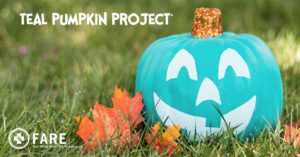![]() As a parent of a child with several life-threatening food allergies, Halloween has always been an especially scary holiday. Considering the fact that 1 in every 13 children have a food allergy, there are three challenges that make Halloween extra tricky to navigate.
As a parent of a child with several life-threatening food allergies, Halloween has always been an especially scary holiday. Considering the fact that 1 in every 13 children have a food allergy, there are three challenges that make Halloween extra tricky to navigate.
Trick #1: Halloween candy has many common allergens.
Many of the most popular Halloween candies contain six of the top eight food allergens (wheat, milk, soy, egg, peanuts, and tree nuts). You can almost guarantee that your child will be handed candy that contains allergens.
Trick #2: Different allergens come in different size treats.
Manufacturers can change ingredients and use different facilities when they make candy in different sizes. That means regular-size candy that is safe can be unsafe in the smaller (or larger) version of the same candy.
Trick #3: Most small candy does not show the ingredient list.
When you have food allergies, you always read the ingredient list before eating anything. Since most small candy doesn’t have an ingredient list on the wrapper, it’s difficult to tell if the candy is safe to eat.
Encouraging a Safe and Inclusive Halloween
 Because of these three big challenges, Food Allergy Research and Education (FARE) has created the Teal Pumpkin Project. This project promotes safe trick-or-treating options for children with food allergies. They suggest having non-food treats items like glow sticks, fake mustaches, bubbles, and bouncy balls. FARE also encourages all families to sign a pledge celebrating safety and inclusion on Halloween and to display a teal pumpkin to signal that you have safe alternatives for trick-or-treating.
Because of these three big challenges, Food Allergy Research and Education (FARE) has created the Teal Pumpkin Project. This project promotes safe trick-or-treating options for children with food allergies. They suggest having non-food treats items like glow sticks, fake mustaches, bubbles, and bouncy balls. FARE also encourages all families to sign a pledge celebrating safety and inclusion on Halloween and to display a teal pumpkin to signal that you have safe alternatives for trick-or-treating.
Getting Creative
To help your child avoid feelings of frustration and disappointment on Halloween, it might be helpful to consider new traditions. For example, you can try one of these creative options:
- Candy Swap: After identifying unsafe candy, have your child trade in the candy they can’t eat for candy that is safe.
- Candy Exchange: Give your child the option to turn in unsafe candy for something else, like a book or a toy. This is also a healthier tradition.
- Candy Donation: Donate the candy to a good cause. Many dentists and organizations accept donations or may offer a “buy-back” program.
- Stay at Home Party: Instead of trick-or-treating, you can suggest hosting a Halloween party, inviting friends to your home, and providing food and treats that you know are safe.
Guidelines for Older Kids
If your kids are older and you are confident they have the maturity to go trick-or-treating without supervision, you might want to implement the following rules:
- Do not eat any candy until you get home.
- Always have at least one buddy with you.
- Carry a fully charged phone.
- Take your epinephrine injector.
With a little bit of creativity, thoughtfulness, and planning, everyone can have an enjoyable Halloween, including kids with food allergies. I often say raising a child with food allergies takes a village. And on behalf of families with food allergies, we truly appreciate everyone who is willing to help keep our kids safe and included this Halloween.

